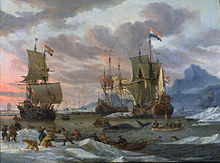
Whaling in the Netherlands was a centuries-long tradition. The history of Dutch whaling begins with 17th-century exploration of Arctic fishing grounds; and the profitability of whaling in the 18th century drove further growth. Increased competition and political upheavals in Europe affected the stability of this maritime industry in the 19th century; and a combination of these factors cut short any further growth of Dutch whaling in the Antarctic.
Modern, post-war whaling in the Southern Ocean was developed intensely, but continued growth of Dutch whaling was abbreviated as a result of multi-national treaties which similarly impacted other national whaling enterprises.[1]
The current Dutch government supports a moratorium on all whaling worldwide.[2]
- ^ Schokkenbroek, p. 19; Bruijn, J. R. "De Nederlandsche Maatschappij voor de Walvischvaart, 1946-1967," Ecconomisch-en sociaal-historisch Jaarboek (ESHJ). Vol. 48 (1985), pp. 233-257.
- ^ Dutch Ministry of Foreign Affairs: "The Netherlands investigates anti-whaling campaign," 5 March 2008.
